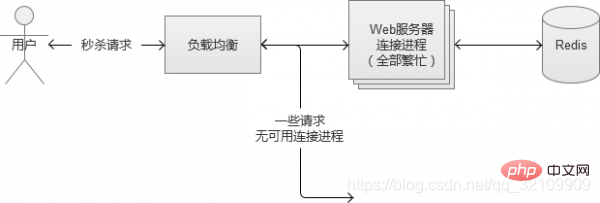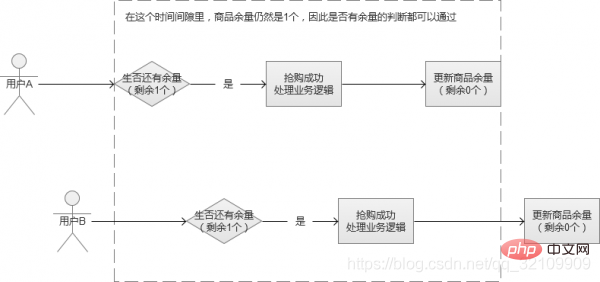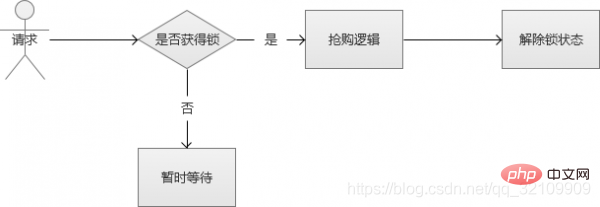 Backend Development
Backend Development
 PHP Tutorial
PHP Tutorial
 How to solve high concurrency problems with PHP? (Source code attached)
How to solve high concurrency problems with PHP? (Source code attached)
How to solve high concurrency problems with PHP? (Source code attached)
The previous article introduced you to "Let us learn more about the if statement of PHP process control statement! ! ! (Source code attached)》, this article continues to introduce PHP to solve high concurrency problems

Video course recommendation →: "Concurrency Solution for Tens of Millions of Data (Theoretical and Practical)"
For example, at a highway intersection, 5 cars come in 1 second, and 5 cars pass by every second, at the highway intersection It works fine. Suddenly, only 4 cars can pass through this intersection in one second, and the traffic flow is still the same. As a result, there will definitely be a traffic jam. (The feeling of 5 lanes suddenly turning into 4 lanes)
Similarly, in a certain second, 20*500 available connection processes are working at full capacity, but there are still 10,000 new requests. , there is no connection process available, and it is expected that the system will fall into an abnormal state.

In fact, in normal non-high-concurrency business scenarios, similar situations occur. There is a problem with a certain business request interface, and the response time is extremely slow. The entire Web request The response time is very long, gradually filling up the number of available connections on the web server, and no connection process is available for other normal business requests.
The more frightening problem is that it is the behavioral characteristics of users. The more unavailable the system is, the more frequent users click. The vicious cycle eventually leads to an "avalanche" (one of the web machines hangs up, causing the traffic to be dispersed to On other machines that are working normally, the normal machines will also hang, and then a vicious circle will occur), bringing down the entire Web system.
Restart and overload protection
If an "avalanche" occurs in the system, restarting the service rashly will not solve the problem. The most common phenomenon is that after starting up, it hangs up immediately. At this time, it is best to deny traffic at the ingress layer and then restart. If services like redis/memcache are also down, you need to pay attention to "warming up" when restarting, and it may take a long time.
In flash sale and rush sale scenarios, the traffic is often beyond our system’s preparation and imagination. At this time, overload protection is necessary. Denying requests is also a protective measure if a full system load condition is detected. Setting up filtering on the front-end is the simplest way, but this approach is a behavior that is "criticized" by users. It is more appropriate to set overload protection at the CGI entry layer to quickly return direct requests from customers
Data security under high concurrency
We know that in many When threads write to the same file, there will be a "thread safety" problem (multiple threads run the same piece of code at the same time, if the result of each run is the same as that of a single-thread run, and the result is the same as expected, it is a thread safe). If it is a MySQL database, you can use its own lock mechanism to solve the problem. However, in large-scale concurrency scenarios, MySQL is not recommended. There is another problem in flash sale and rush sale scenarios, which is "over-delivery". If this aspect is not controlled carefully, excessive delivery will occur. We have also heard that some e-commerce companies conduct rush buying activities. After the buyer successfully purchases the product, the merchant does not recognize the order as valid and refuses to deliver the goods. The problem here may not necessarily be that the merchant is treacherous, but that it is caused by the risk of over-issuance at the technical level of the system.
- The reason for over-issuance
Assume that in a certain rush-buying scenario, we only have 100 products in total, and at the last moment, we have already consumed them 99 items, only the last one left. At this time, the system sent multiple concurrent requests. The product balances read by these requests were all 99, and then they all passed this balance judgment, which eventually led to over-issuance. (Same as the scene mentioned earlier in the article)

In the picture above, it resulted in concurrent user B also "successfully buying", allowing one more person to obtain the product. This scenario is very easy to occur in high concurrency situations.
Optimization plan 1: Set the inventory field number field to unsigned. When the inventory is 0, because the field cannot be a negative number, false will be returned
<?php //优化方案1:将库存字段number字段设为unsigned,当库存为0时,因为字段不能为负数,将会返回false
include('./mysql.php');
$username = 'wang'.rand(0,1000);
//生成唯一订单
function build_order_no(){
return date('ymd').substr(implode(NULL, array_map('ord', str_split(substr(uniqid(), 7, 13), 1))), 0, 8);
}
//记录日志
function insertLog($event,$type=0,$username){
global $conn;
$sql="insert into ih_log(event,type,usernma)
values('$event','$type','$username')";
return mysqli_query($conn,$sql);
}
function insertOrder($order_sn,$user_id,$goods_id,$sku_id,$price,$username,$number)
{
global $conn;
$sql="insert into ih_order(order_sn,user_id,goods_id,sku_id,price,username,number)
values('$order_sn','$user_id','$goods_id','$sku_id','$price','$username','$number')";
return mysqli_query($conn,$sql);
}
//模拟下单操作
//库存是否大于0
$sql="select number from ih_store where goods_id='$goods_id' and sku_id='$sku_id' ";
$rs=mysqli_query($conn,$sql);
$row = $rs->fetch_assoc();
if($row['number']>0){//高并发下会导致超卖
if($row['number']0";
$store_rs=mysqli_query($conn,$sql);
if($store_rs){
//生成订单
insertOrder($order_sn,$user_id,$goods_id,$sku_id,$price,$username,$number);
insertLog('库存减少成功',1,$username);
}else{
insertLog('库存减少失败',2,$username);
}
}else{
insertLog('库存不够',3,$username);
}
?>- pessimistic lock ideas
There are many ideas to solve thread safety, and we can start the discussion from the direction of "pessimistic lock".
Pessimistic lock, that is, when modifying data, the lock state is adopted to exclude modifications from external requests. When encountering a locked state, you must wait.

虽然上述的方案的确解决了线程安全的问题,但是,别忘记,我们的场景是“高并发”。也就是说,会很多这样的修改请求,每个请求都需要等待“锁”,某些线程可能永远都没有机会抢到这个“锁”,这种请求就会死在那里。同时,这种请求会很多,瞬间增大系统的平均响应时间,结果是可用连接数被耗尽,系统陷入异常。
优化方案2:使用MySQL的事务,锁住操作的行
<?php //优化方案2:使用MySQL的事务,锁住操作的行
include('./mysql.php');
//生成唯一订单号
function build_order_no(){
return date('ymd').substr(implode(NULL, array_map('ord', str_split(substr(uniqid(), 7, 13), 1))), 0, 8);
}
//记录日志
function insertLog($event,$type=0){
global $conn;
$sql="insert into ih_log(event,type)
values('$event','$type')";
mysqli_query($conn,$sql);
}
//模拟下单操作
//库存是否大于0
mysqli_query($conn,"BEGIN"); //开始事务
$sql="select number from ih_store where goods_id='$goods_id' and sku_id='$sku_id' FOR UPDATE";//此时这条记录被锁住,其它事务必须等待此次事务提交后才能执行
$rs=mysqli_query($conn,$sql);
$row=$rs->fetch_assoc();
if($row['number']>0){
//生成订单
$order_sn=build_order_no();
$sql="insert into ih_order(order_sn,user_id,goods_id,sku_id,price)
values('$order_sn','$user_id','$goods_id','$sku_id','$price')";
$order_rs=mysqli_query($conn,$sql);
//库存减少
$sql="update ih_store set number=number-{$number} where sku_id='$sku_id'";
$store_rs=mysqli_query($conn,$sql);
if($store_rs){
echo '库存减少成功';
insertLog('库存减少成功');
mysqli_query($conn,"COMMIT");//事务提交即解锁
}else{
echo '库存减少失败';
insertLog('库存减少失败');
}
}else{
echo '库存不够';
insertLog('库存不够');
mysqli_query($conn,"ROLLBACK");
}
?>- FIFO队列思路
那好,那么我们稍微修改一下上面的场景,我们直接将请求放入队列中的,采用FIFO(First Input First Output,先进先出),这样的话,我们就不会导致某些请求永远获取不到锁。看到这里,是不是有点强行将多线程变成单线程的感觉哈。

然后,我们现在解决了锁的问题,全部请求采用“先进先出”的队列方式来处理。那么新的问题来了,高并发的场景下,因为请求很多,很可能一瞬间将队列内存“撑爆”,然后系统又陷入到了异常状态。或者设计一个极大的内存队列,也是一种方案,但是,系统处理完一个队列内请求的速度根本无法和疯狂涌入队列中的数目相比。也就是说,队列内的请求会越积累越多,最终Web系统平均响应时候还是会大幅下降,系统还是陷入异常。
-
文件锁的思路
对于日IP不高或者说并发数不是很大的应用,一般不用考虑这些!用一般的文件操作方法完全没有问题。但如果并发高,在我们对文件进行读写操作时,很有可能多个进程对进一文件进行操作,如果这时不对文件的访问进行相应的独占,就容易造成数据丢失
优化方案4:使用非阻塞的文件排他锁
<?php //优化方案4:使用非阻塞的文件排他锁
include ('./mysql.php');
//生成唯一订单号
function build_order_no(){
return date('ymd').substr(implode(NULL, array_map('ord', str_split(substr(uniqid(), 7, 13), 1))), 0, 8);
}
//记录日志
function insertLog($event,$type=0){
global $conn;
$sql="insert into ih_log(event,type)
values('$event','$type')";
mysqli_query($conn,$sql);
}
$fp = fopen("lock.txt", "w+");
if(!flock($fp,LOCK_EX | LOCK_NB)){
echo "系统繁忙,请稍后再试";
return;
}
//下单
$sql="select number from ih_store where goods_id='$goods_id' and sku_id='$sku_id'";
$rs = mysqli_query($conn,$sql);
$row = $rs->fetch_assoc();
if($row['number']>0){//库存是否大于0
//模拟下单操作
$order_sn=build_order_no();
$sql="insert into ih_order(order_sn,user_id,goods_id,sku_id,price)
values('$order_sn','$user_id','$goods_id','$sku_id','$price')";
$order_rs = mysqli_query($conn,$sql);
//库存减少
$sql="update ih_store set number=number-{$number} where sku_id='$sku_id'";
$store_rs = mysqli_query($conn,$sql);
if($store_rs){
echo '库存减少成功';
insertLog('库存减少成功');
flock($fp,LOCK_UN);//释放锁
}else{
echo '库存减少失败';
insertLog('库存减少失败');
}
}else{
echo '库存不够';
insertLog('库存不够');
}
fclose($fp);
?> <?php //优化方案4:使用非阻塞的文件排他锁
include ('./mysql.php');
//生成唯一订单号
function build_order_no(){
return date('ymd').substr(implode(NULL, array_map('ord', str_split(substr(uniqid(), 7, 13), 1))), 0, 8);
}
//记录日志
function insertLog($event,$type=0){
global $conn;
$sql="insert into ih_log(event,type)
values('$event','$type')";
mysqli_query($conn,$sql);
}
$fp = fopen("lock.txt", "w+");
if(!flock($fp,LOCK_EX | LOCK_NB)){
echo "系统繁忙,请稍后再试";
return;
}
//下单
$sql="select number from ih_store where goods_id='$goods_id' and sku_id='$sku_id'";
$rs = mysqli_query($conn,$sql);
$row = $rs->fetch_assoc();
if($row['number']>0){//库存是否大于0
//模拟下单操作
$order_sn=build_order_no();
$sql="insert into ih_order(order_sn,user_id,goods_id,sku_id,price)
values('$order_sn','$user_id','$goods_id','$sku_id','$price')";
$order_rs = mysqli_query($conn,$sql);
//库存减少
$sql="update ih_store set number=number-{$number} where sku_id='$sku_id'";
$store_rs = mysqli_query($conn,$sql);
if($store_rs){
echo '库存减少成功';
insertLog('库存减少成功');
flock($fp,LOCK_UN);//释放锁
}else{
echo '库存减少失败';
insertLog('库存减少失败');
}
}else{
echo '库存不够';
insertLog('库存不够');
}
fclose($fp);
?>- 乐观锁思路
这个时候,我们就可以讨论一下“乐观锁”的思路了。乐观锁,是相对于“悲观锁”采用更为宽松的加锁机制,大都是采用带版本号(Version)更新。实现就是,这个数据所有请求都有资格去修改,但会获得一个该数据的版本号,只有版本号符合的才能更新成功,其他的返回抢购失败。这样的话,我们就不需要考虑队列的问题,不过,它会增大CPU的计算开销。但是,综合来说,这是一个比较好的解决方案。

有很多软件和服务都“乐观锁”功能的支持,例如Redis中的watch就是其中之一。通过这个实现,我们保证了数据的安全。
优化方案5:Redis中的watch
<?php $redis = new redis();
$result = $redis->connect('127.0.0.1', 6379);
echo $mywatchkey = $redis->get("mywatchkey");
/*
//插入抢购数据
if($mywatchkey>0)
{
$redis->watch("mywatchkey");
//启动一个新的事务。
$redis->multi();
$redis->set("mywatchkey",$mywatchkey-1);
$result = $redis->exec();
if($result) {
$redis->hSet("watchkeylist","user_".mt_rand(1,99999),time());
$watchkeylist = $redis->hGetAll("watchkeylist");
echo "抢购成功!<br>";
$re = $mywatchkey - 1;
echo "剩余数量:".$re."<br>";
echo "用户列表:<pre class="brush:php;toolbar:false">";
print_r($watchkeylist);
}else{
echo "手气不好,再抢购!";exit;
}
}else{
// $redis->hSet("watchkeylist","user_".mt_rand(1,99999),"12");
// $watchkeylist = $redis->hGetAll("watchkeylist");
echo "fail!<br>";
echo ".no result<br>";
echo "用户列表:<pre class="brush:php;toolbar:false">";
// var_dump($watchkeylist);
}*/
$rob_total = 100; //抢购数量
if($mywatchkeywatch("mywatchkey");
$redis->multi(); //在当前连接上启动一个新的事务。
//插入抢购数据
$redis->set("mywatchkey",$mywatchkey+1);
$rob_result = $redis->exec();
if($rob_result){
$redis->hSet("watchkeylist","user_".mt_rand(1, 9999),$mywatchkey);
$mywatchlist = $redis->hGetAll("watchkeylist");
echo "抢购成功!<br>";
echo "剩余数量:".($rob_total-$mywatchkey-1)."<br>";
echo "用户列表:<pre class="brush:php;toolbar:false">";
var_dump($mywatchlist);
}else{
$redis->hSet("watchkeylist","user_".mt_rand(1, 9999),'meiqiangdao');
echo "手气不好,再抢购!";exit;
}
}
?>推荐学习:《PHP视频教程》
The above is the detailed content of How to solve high concurrency problems with PHP? (Source code attached). For more information, please follow other related articles on the PHP Chinese website!

Hot AI Tools

Undresser.AI Undress
AI-powered app for creating realistic nude photos

AI Clothes Remover
Online AI tool for removing clothes from photos.

Undress AI Tool
Undress images for free

Clothoff.io
AI clothes remover

AI Hentai Generator
Generate AI Hentai for free.

Hot Article

Hot Tools

Notepad++7.3.1
Easy-to-use and free code editor

SublimeText3 Chinese version
Chinese version, very easy to use

Zend Studio 13.0.1
Powerful PHP integrated development environment

Dreamweaver CS6
Visual web development tools

SublimeText3 Mac version
God-level code editing software (SublimeText3)

Hot Topics
 Working with Flash Session Data in Laravel
Mar 12, 2025 pm 05:08 PM
Working with Flash Session Data in Laravel
Mar 12, 2025 pm 05:08 PM
Laravel simplifies handling temporary session data using its intuitive flash methods. This is perfect for displaying brief messages, alerts, or notifications within your application. Data persists only for the subsequent request by default: $request-
 cURL in PHP: How to Use the PHP cURL Extension in REST APIs
Mar 14, 2025 am 11:42 AM
cURL in PHP: How to Use the PHP cURL Extension in REST APIs
Mar 14, 2025 am 11:42 AM
The PHP Client URL (cURL) extension is a powerful tool for developers, enabling seamless interaction with remote servers and REST APIs. By leveraging libcurl, a well-respected multi-protocol file transfer library, PHP cURL facilitates efficient execution of various network protocols, including HTTP, HTTPS, and FTP. This extension offers granular control over HTTP requests, supports multiple concurrent operations, and provides built-in security features.
 Simplified HTTP Response Mocking in Laravel Tests
Mar 12, 2025 pm 05:09 PM
Simplified HTTP Response Mocking in Laravel Tests
Mar 12, 2025 pm 05:09 PM
Laravel provides concise HTTP response simulation syntax, simplifying HTTP interaction testing. This approach significantly reduces code redundancy while making your test simulation more intuitive. The basic implementation provides a variety of response type shortcuts: use Illuminate\Support\Facades\Http; Http::fake([ 'google.com' => 'Hello World', 'github.com' => ['foo' => 'bar'], 'forge.laravel.com' =>
 12 Best PHP Chat Scripts on CodeCanyon
Mar 13, 2025 pm 12:08 PM
12 Best PHP Chat Scripts on CodeCanyon
Mar 13, 2025 pm 12:08 PM
Do you want to provide real-time, instant solutions to your customers' most pressing problems? Live chat lets you have real-time conversations with customers and resolve their problems instantly. It allows you to provide faster service to your custom
 PHP Logging: Best Practices for PHP Log Analysis
Mar 10, 2025 pm 02:32 PM
PHP Logging: Best Practices for PHP Log Analysis
Mar 10, 2025 pm 02:32 PM
PHP logging is essential for monitoring and debugging web applications, as well as capturing critical events, errors, and runtime behavior. It provides valuable insights into system performance, helps identify issues, and supports faster troubleshoot
 Explain the concept of late static binding in PHP.
Mar 21, 2025 pm 01:33 PM
Explain the concept of late static binding in PHP.
Mar 21, 2025 pm 01:33 PM
Article discusses late static binding (LSB) in PHP, introduced in PHP 5.3, allowing runtime resolution of static method calls for more flexible inheritance.Main issue: LSB vs. traditional polymorphism; LSB's practical applications and potential perfo
 HTTP Method Verification in Laravel
Mar 05, 2025 pm 04:14 PM
HTTP Method Verification in Laravel
Mar 05, 2025 pm 04:14 PM
Laravel simplifies HTTP verb handling in incoming requests, streamlining diverse operation management within your applications. The method() and isMethod() methods efficiently identify and validate request types. This feature is crucial for building
 Discover File Downloads in Laravel with Storage::download
Mar 06, 2025 am 02:22 AM
Discover File Downloads in Laravel with Storage::download
Mar 06, 2025 am 02:22 AM
The Storage::download method of the Laravel framework provides a concise API for safely handling file downloads while managing abstractions of file storage. Here is an example of using Storage::download() in the example controller:





